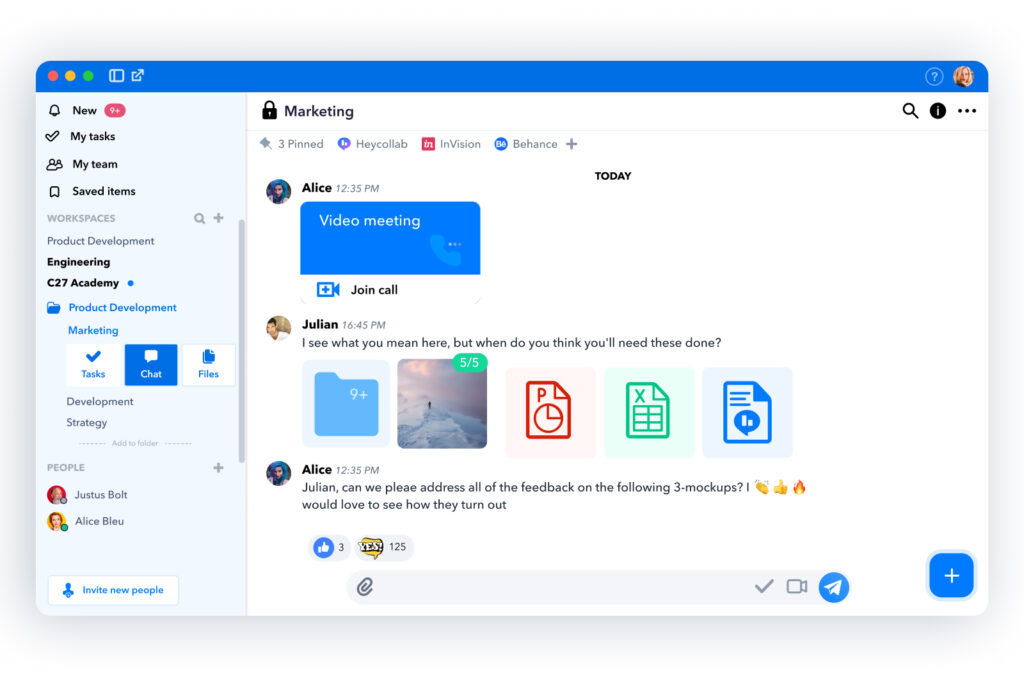Nine million Americans work from home at least half time, according to FlexJob’s State of Telecommuting report. That’s about three percent of the total U.S. labor force and a big jump from the 1.8 million who did so in 2005. It’s a growing perk, but also an incredibly in-demand one.
About 76 percent of millennials would take a pay cut of at least three percent in order to work for a company that provides flexible work arrangements, according to research from software firm Qualtrics and venture capital firm Accel Partners. (The most important benefit according to those surveyed, by the way, was health-care coverage. In-office perks, like games and sports, were the least.)
As remote work continues to be something sought-out by employees, and a perk that more companies are offering, the topic of remote team collaboration becomes vital to discuss. In some organizations that collaboration will include employees in multiple company locations as well as some in work-from-home settings. Other businesses may be facilitating the collaboration of fully remote teams within an entirely distributed workforce. But regardless of the exact makeup of the team, if all members aren’t routinely in the same place, then an entirely different type of work is actually taking place. Remote collaboration is often found to be more productive, efficient and enjoyable than traditional collaboration. However, the key is not to assume that the same practices that work in-office can be applied to remote teams. Here, we’ve gathered critical steps for fostering excellent remote teamwork.
1) Don’t Assume There’s Understanding
 Put six humans in a room, have them talk to each other, then survey their experiences and an interesting thing will happen. They’ll likely each have a slightly different interpretation of how participants were feeling and what they were thinking during their time in that room. Now, take that same group and move them to the phone and those interpretations become even more varied. When the additional information provided by facial expressions and body language is removed from the situation it’s harder for team members to suss out precisely where their colleagues are coming from properly. Turn that dial up even further if you’re relying on email as a communication tool!
Put six humans in a room, have them talk to each other, then survey their experiences and an interesting thing will happen. They’ll likely each have a slightly different interpretation of how participants were feeling and what they were thinking during their time in that room. Now, take that same group and move them to the phone and those interpretations become even more varied. When the additional information provided by facial expressions and body language is removed from the situation it’s harder for team members to suss out precisely where their colleagues are coming from properly. Turn that dial up even further if you’re relying on email as a communication tool!
The worst part? Knowing each other well doesn’t change that fact. It’s a common assumption that if teams have been working together a long time, or know each other well, that they will be able to sidestep this remote-work issue. Researchers at Chatham University, however, found that friends were, in fact, no were no better than strangers at correctly identifying the writer’s intended emotion in the text of an email. Participants in the study described their own confidence in being able both to communicate via email effectively and properly identify others’ emotions in an email, as generally very high. What the researchers found, however, is that the participants’ confidence was misplaced. Readers might be able to identify that the writer of an email was angry, for instance, but be unable to tell the level of anger that the author was feeling. There is a great deal of meaning that can be missed if a reader believes their manager is furious when in fact they’re merely perturbed.
The solution isn’t to skip using email, but rather never to assume that the emotions behind the words being sent are clear to anyone other than the sender. Organizations may wish to set norms for expressing or describing emotion via email, and coach their team members to explicitly note the way that they feel when relevant. For instance, adding the phrase “I’m not mad, but I do feel frustration that…” could help to resolve some confusion. For emotionally charged situations, using video chat to infuse facial expressions and body language into the mix may be preferable.
2) Give Everyone a Job
 Indi Young is the founder of Adaptive Path, a company that organizes design events. When he broke his leg while running and found himself homebound for an extended period of time, he took it as an opportunity to refine his remote-team management skills. Young shares that while it’s always going to be easier to rally a group of on-site workers, you may accomplish more with a motivated remote team.
Indi Young is the founder of Adaptive Path, a company that organizes design events. When he broke his leg while running and found himself homebound for an extended period of time, he took it as an opportunity to refine his remote-team management skills. Young shares that while it’s always going to be easier to rally a group of on-site workers, you may accomplish more with a motivated remote team.
One way Young creates that much-needed engagement for his remote teams is by assigning roles to his employees in advance of a meeting. He might ask one person to be the timekeeper and ensure that the meeting keeps to the schedule set forth in the agenda. That might mean little “five more minutes” notifications when folks are speaking, or a message sent within a team collaboration tool such as Heycollab. Young might tap another employee to log issues that come up during the meeting. And he might request that another staff member be responsible for the meeting notes. There are many additional jobs that team members might take on during a video chat or phone call, and each person in the meeting should have a task.
3) Respect People’s Time
 This should be part of every professional’s plan. It shouldn’t take the constraints of remote collaboration in order to add respect of team members’ time to the repertoire. However, it becomes of increased importance when employees are collaborating remotely. Part and parcel to asynchronous collaboration is preparation. And preparation is one of the key ways that remote collaborators respect each other’s time. If everyone is being called to be live on the phone–or the video chat–together at the same time there should be a compelling reason. But once that litmus test has been met, there needs to be pre-work. Whoever is calling the meeting needs to gather all of the materials, background information, opinions, documents and tools required to make the meeting as productive as possible. Remote collaboration calls for every minute of live meeting time to be used as responsibly as possible.
This should be part of every professional’s plan. It shouldn’t take the constraints of remote collaboration in order to add respect of team members’ time to the repertoire. However, it becomes of increased importance when employees are collaborating remotely. Part and parcel to asynchronous collaboration is preparation. And preparation is one of the key ways that remote collaborators respect each other’s time. If everyone is being called to be live on the phone–or the video chat–together at the same time there should be a compelling reason. But once that litmus test has been met, there needs to be pre-work. Whoever is calling the meeting needs to gather all of the materials, background information, opinions, documents and tools required to make the meeting as productive as possible. Remote collaboration calls for every minute of live meeting time to be used as responsibly as possible.
The organizer isn’t the only one who needs to do their pre-work, however. The person managing the meeting should be in touch with those who will attend the meeting ahead of time and share documents that need to be reviewed in advance–including the agenda. Questions or concerns about the agenda should be addressed in advance, and all pre-reads should be consumed as requested.
Once everyone’s together, do only those things that require live collaboration–or at least are best done that way. Don’t use meeting time to do things that are easily accomplished using Slack. Make decisions, finalize plans. If you’ve got the whole team stopping work to do this, it better need doing, and it better need doing via a live meeting.
4) Get the Right Tools

Typical companies save about $11,000 per person per year when they adopt remote work policies, according to a study by Global Workplace Analytics study. There are myriad other ways that an individual employee may find that they save time and money. But there are some expenditures that need to be made in order to maximize collaboration quality within remote teams, as well. That’s because remote teams need excellent tools to foster their work together. No matter what industry a group of employees is working in, there are a number of types of tools that companies should consider providing them with. Those types of tools include:
- an online calendar tool,
- a video conferencing application,
- a project management tool
- an instant messaging app, and
- a remote file management system.
For those organizations that employ Heycollab, most of those tools can be found within the software. Heycollab’s Team Workspaces accomplish the goal of providing a spot for employee chat and instant messaging, as well as task and project management. Teams using Heycollab can share not only messages but also files and a variety of project assets.

